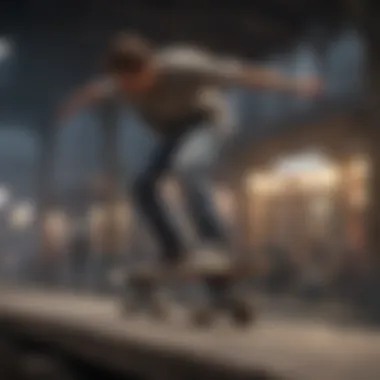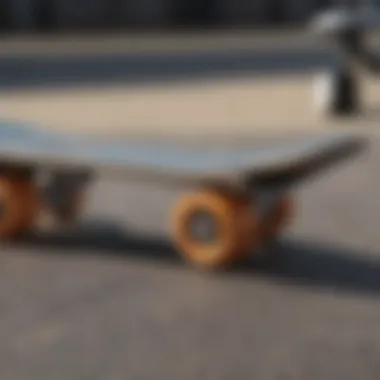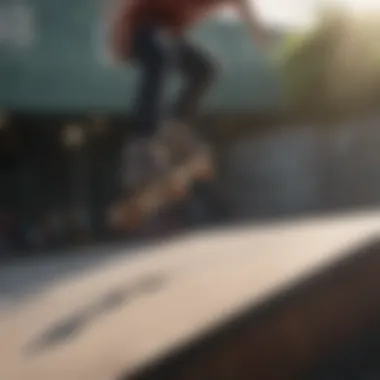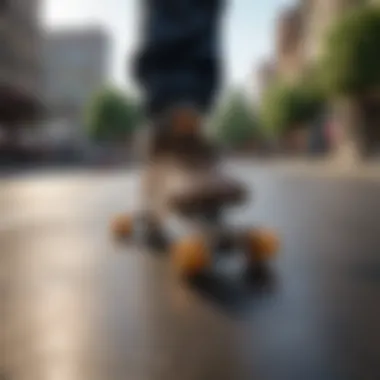Mastering Balance: The Key to Skateboarding Success


Intro
Balance represents one of the most vital skills in skateboarding. Without proper balance, even the most experienced skateboarders struggle to perform effectively. This article addresses the importance of balance in the context of skateboarding by exploring its impact on technique, performance, and safety. It also provides practical advice for enhancing balance, insights on equipment choices, and strategies for personal growth in the sport.
Achieving balance requires more than physical coordination; it involves understanding one’s body and how it interacts with the skateboard. The goal here is to cultivate a deeper appreciation for the role balance plays at every level of skateboarding.
Skateboarding News Updates
The skateboarding world constantly evolves with events and innovations that impact practitioners significantly. Understanding the latest updates helps skateboarders stay informed and enhance their skills.
Skate Competitions Recap
Skateboarding competitions offer an ideal showcase for balance and technique. Recent events saw skilled athletes pushing the limits of what is possible on a board. These competitions not only highlight individual talent but also reveal new trends in performance that can inspire aspiring skateboarders.
New Product Launches
The market sees a constant arrival of new skateboarding gear engineered to enhance stability and performance. Products such as skateboard decks with advanced materials or trucks designed for better balance have a considerable influence on how skaters perform tricks and maneuvers. Checking for product developements will help skaters choose equipment that aligns with their balance needs.
Skateboarding Events Coverage
Events such as workshops and festivals offer opportunities for skaters to connect with one another and learn from experts. Participating in these events can provide insights into maintaining balance and improving skills. Learning from seasoned skateboarders also helps individuals develop their unique style while focusing on balance.
Trick Tutorials and Guides
Mastering tricks is inherently linked to maintaining balance. Therefore, understanding how to execute them effectively is essential for skaters of all levels.
Beginner Tricks Breakdown
Beginners often start with fundamental tricks like the ollie and the kickflip. Focusing on body posture and weight distribution when learning these tricks helps build a solid foundation. Key points include keeping the knees bent to absorb shocks and learning to spot the landing to maintain balance.
Advanced Trick Tips
More advanced tricks such as 540s and grinds require precision balance. It is necessary to fine-tune slight adjustments in body position to maintain control throughout each movement. Practicing these tricks consistently can improve muscle memory and overall balance.
Freestyle and Street Skate Techniques
Freestyle operations and street skating involve complex balance skills. Techniques such as manuals and nose stalls require significant stability. Practicing these in a controlled environment helps athletes hone their abilities before attempting them in more challenging settings.
Skateboarding Culture and Lifestyle
Skateboarding is more than a sport; it is a lifestyle rooted in community and culture. Navigating these aspects can deepen one’s commitment to balance as a practice.
Skateboarding Influencer Spotlights
Influencers highlight the significance of balance in their techniques and styles. Following these individuals provides valuable insights about approaches to skateboarding and the pursuit of improved balance through their experiences.
Skatepark Reviews
Visiting different skateparks exposes skateboarders to diverse facilities and surfaces that challenge their balance. Reviews of these parks can guide enthusiasts to suitable locations for practicing their skills.
Skateboarding Fashion Trends
Fashion also plays a role in skateboarding culture. Choosing appropriate clothing that allows freedom of movement contributes indirectly to balance when skating.
Gear Reviews and Recommendations
Selecting the right skateboard gear can significantly enhance balance and safety while riding.
Skateboard Deck Reviews
Various skateboard decks with differing widths and materials affect balance. Testing different boards can reveal which best supports a skateboarder’s personal style and balance.
Truck and Wheel Comparisons
Scootering produces performance variances based on foot positioning and weight distribution. Assessing truck sizes and wheel hardness can help discover a balance that suits individual riding styles.
Protective Gear Suggestions
Wearing proper protective gear, such as helmets and pads, contributes to safety and confidence. Knowing one’s limits and padding accordingly allows skateboarders to focus on developing balance without fear of injury.
Healthy Lifestyle for Skaters
A holistic approach towards fitness helps improve overall balance and performance in skateboarding.


Injury Prevention Exercises
Engaging in exercises focused on core strength can enhance balance. Techniques such as planks and balance boards can be incorporated into a regular training regimen.
Skateboard Fitness and Strength Training
Developing strength through gym workouts can support muscles crucial for balance. Activities such as squats and lunges help build the necessary musculature.
Nutrition Tips for Skaters
Proper nutrition contributes to endurance and recovery. A balanced diet allows for sustained performance during practice sessions, ensuring that skateboarders can focus on refining their skills.
Focus on balance; it is the foundation of every successful skateboarding maneuver.
Intro to Balance in Skateboarding
Balance is a fundamental element of skateboarding that influences technique, performance, and safety. It dictates a skater's ability to control their board and navigate various terrains. Poor balance can lead to falls, injuries, and reduced confidence while riding. Therefore, understanding balance is crucial for any skateboarder, whether a novice or an advanced rider.
Skateboarding demands precise coordination between the body and the board. A balanced stance allows for effortless transitions between stances, enabling skaters to execute tricks smoothly. When skaters develop effective balance, they can push their limits, exploring new tricks and styles with greater ease.
In this section, we will define balance in the context of skateboarding and explain its importance for skaters. Comprehending these concepts is vital for anyone looking to improve their skills on the board.
Defining Balance in Skateboarding
Balance in skateboarding refers to the ability of the skater to remain stable while on the board. This stability is crucial when performing tricks, navigating obstacles, or even riding on flat terrain. It involves several factors, including the distribution of weight, the position of the feet, and the center of gravity.
A skater's center of gravity changes depending on their position and movements. This adjustment is crucial, especially during tricks like ollies or kickflips. Maintaining balance means continuously adjusting these elements to ensure the board stays underneath the rider’s feet.
Importance of Balance for Skaters
The significance of balance for skaters cannot be overstated. Here are some key points to consider:
- Safety: A strong sense of balance reduces the risk of injury. Skaters who can maintain their balance are less likely to fall and sustain injuries.
- Technique: Good balance is essential to performing tricks effectively. Whether it's a simple turn or a complicated flip trick, balance plays a pivotal role.
- Confidence: Mastering balance boosts a skater's self-assurance. As balance improves, so does the willingness to attempt new tricks, fostering personal growth in the sport.
"Mastery of balance leads to mastery of the board." - Anonymous
Building balance requires practice and dedication, but it is a worthwhile endeavor that can significantly enhance a skateboarder’s experience and skills.
The Physics of Balance
Understanding the physics of balance is central to skateboarding. Skateboarding involves dynamic movements where stability and control are critical. Without a solid grasp of the physical principles that govern balance, skaters may struggle to master techniques and achieve desired performance levels. This section unpacks two fundamental components of balance: center of gravity and weight distribution. Each plays a significant role in how skateboarders execute tricks and maintain stability.
Center of Gravity
The center of gravity is an essential concept in balancing effectively on a skateboard. It is the point where an object's mass is evenly distributed in all directions. For skateboarders, maintaining a low center of gravity enhances balance. When a skater bends their knees and lowers their posture, they effectively reduce the height of their center of gravity. This action increases stability, enabling skaters to maneuver with greater precision.
To illustrate this, think of a tightrope walker. They often use a long pole to help maintain balance, which shifts their center of gravity. In skateboarding, the body functions similarly. A skater's ability to control their center of gravity dictates how well they can perform tricks like ollies and grinds.
Weight Distribution
Equally as important as the center of gravity is how weight is distributed across the skateboard. Weight distribution refers to how the skater's body weight is spread over the board while performing. Different maneuvers often require specific weight shifts. For example, during an ollie, a skater needs to lean back slightly to lift the front of the board. This shift is crucial for achieving the necessary height and airtime.
Skaters should always be mindful of their weight alignment. An uneven weight distribution can lead to loss of control or falling. To maintain balance, skaters can practice various drills focusing on shifting weight forward or backward while rolling.
"Proper weight distribution on the skateboard is not just about staying upright; it is fundamental to executing tricks successfully."
Techniques to Improve Balance
Balance in skateboarding is crucial for success in mastering tricks and maintaining control. Thus, implementing effective techniques to enhance balance becomes a necessity for skaters aiming for improvement. Not only does solid balance support better performance, but it also plays a key role in safety while skating. In this section, we will explore methods to develop balance, focusing on both basic and advanced techniques.
Basic Balance Exercises
Basic balance exercises are suitable for all skill levels and can be integrated into daily routines. They help in establishing a strong foundation for balance while riding on a skateboard.
- Stance Practice: Start by standing on your board without rolling. Shift your weight from heel to toe. This will help you understand weight distribution and how your body reacts under pressure.
- Balance Boards: Use a balance board to enhance your core strength and stability. Engaging with a balance board develops the relevant muscle groups needed for skating.
- Single-Leg Stands: Try standing on one leg for as long as possible. This simple exercise strengthens your stabilizer muscles. It also mimics the balance needed while performing tricks.
- Wall Support: Lean against a wall and practice shifting weight from side to side. This helps in becoming familiar with keeping balance without the fear of falling.
Incorporating these exercises into your routine can lead to noticeable improvements in your overall balance. A solid grip on basic exercises serves as the groundwork for more complicated drills.
Advanced Balance Drills
Once basic balance skills are established, skaters can progress to advanced drills. These exercises mimic the dynamic movements encountered in skateboarding.
- Trick Balance Drills: Utilize a soft surface, like a yoga mat, to practice landing tricks. Focus on maintaining balance upon landing to reinforce muscle memory.
- Dynamic Movements: Incorporate side lunges or squat jumps to challenge your balance. These movements improve the coordination of your lower body in relation to your center of gravity. This is crucial for successfully executing tricks.
- Obstacle Course: Set up obstacles like cones or small ramps to navigate while balancing on your board. The changing environment forces your body to adapt quickly, enhancing balance.
- Partner Drills: Have a partner create dynamic movements or sudden changes in direction while you attempt to maintain balance. This can simulate the unpredictability of a skatepark or natural terrain.


A consistent balance training regimen fosters adaptability and resilience on the board. Understanding your own limits and continuously challenging yourself is vital for growth.
Engaging in these advanced drills not only amplifies balance skills but contributes to overall skateboarding proficiency. As balance improves, skaters will find themselves executing tricks with more precision and confidence.
Balance and Trick Performance
Balance is critical in skateboarding, directly influencing trick execution, safety, and overall performance. It serves as the foundation upon which skateboarding skills are built. When skaters possess a solid sense of balance, they can execute complex maneuvers with precision. Tricks often require weight shifts and body coordination, which makes balance a vital component. Without it, even the simplest trick can become difficult or even dangerous.
A strong sense of balance enables skateboarders to maintain control. This control is essential during moments of high speed or unexpected changes in terrain. Tricks such as ollies and kickflips rely heavily on balance. Mastering these tricks requires a combination of intuition, practice, and an understanding of the body's center of gravity. Thus, developing balance is not just about physical capability; it also involves mental preparedness and confidence in one's abilities.
"Balance integrates body and mind, making skateboarding not just a sport, but an art form."
Essential Tricks Requiring Balance
Several tricks are particularly dependent on balance. These types of tricks can vary in complexity, but all of them fundamentally rely on a skater's ability to maintain stability on the board. Some essential tricks that highlight the importance of balance include:
- Ollie: This foundational trick involves popping the tail of the board while jumping into the air. A skater must remain balanced to control the elevation and direction.
- Kickflip: A step beyond the ollie, the kickflip requires flicking the board while airborne. Maintaining balance during this trick is crucial to landing successfully.
- Heelflip: Similar to the kickflip, it requires skaters to flip the board with their heel. Balance plays an essential role in the timing and coordination needed for proper execution.
- Grabs: Tricks that involve grabbing the board mid-air rely on strong core stability. A skater must keep their weight centered to execute and land these tricks effectively.
Mastering these tricks can take time and effort. However, with a focus on balance, skateboarders can enhance their performance and broaden their trick repertoire.
Common Mistakes and Corrections
As skateboarders aim to improve their balance in trick performance, they may encounter common mistakes that hinder progress. Recognizing and correcting these issues is vital for growth. Some frequent errors include:
- Incorrect Weight Distribution: Many skaters struggle with where to place their weight. If too much weight is on the back or front, it can lead to falls. To improve, skaters should practice keeping their weight centered over the board.
- Poor Body Alignment: Maintaining proper posture can affect balance. Skaters sometimes lean too far forward or backward. Regularly checking body alignment during tricks can help ensure greater stability.
- Inadequate Core Strength: A weak core can impact balance significantly. Incorporating exercises such as planks or balance boards in training can build core strength, aiding overall balance.
- Rushing the Trick: Hurrying through the execution of a trick can lead to mistakes. Practicing controlled movements ensures that skaters have time to adjust their balance when needed.
By understanding these common pitfalls and taking corrective actions, skateboarders can refine their balance and achieve better outcomes in their trick performance.
The Role of Equipment in Balance
In the realm of skateboarding, equipment plays a crucial role in achieving and maintaining balance. From the board itself to the shoes worn by the skater, each element contributes to overall stability, performance, and safety. Understanding how different equipment affects balance can lead to improved technique and greater enjoyment of the sport.
Choosing the Right Board
Selecting the most suitable skateboard is a vital consideration for skaters aiming to enhance their balance. Factors such as deck width, length, and shape influence how easily a skater can maintain balance while performing tricks or riding. For example, a wider deck provides more foot space, making it easier for beginners to find stability. Conversely, advanced skaters might opt for a narrower board that allows for quicker foot movements while sacrificing some stability.
- Material: The construction material of the board also impacts balance. A flexible board can absorb shocks and create a smoother ride, aiding balance on uneven surfaces.
- Trucks: The type and height of the trucks can affect balance too. Lower trucks can offer more stability, while higher trucks allow for greater maneuverability, which may suit different riding styles.
Choosing the right board is not just about comfort; it is about enhancing skills and achieving optimal performance on the skatepark.
Impact of Footwear on Balance
Footwear is another significant factor that greatly affects a skater's balance. The design and fit of skate shoes can enhance grip on the board and provide adequate support. Proper footwear ensures that the rider feels connected to their skateboard, which is crucial for managing balance.
- Sole Material: Shoes with a flat and grippy sole give better board feel and traction, crucial during tricks like ollies or kickflips.
- Ankle Support: Some skate shoes come with higher designs that offer additional support to the ankle. This can lead to an increased sense of stability, especially for skaters who perform complex tricks.
"The right shoes can make the difference between landing a trick and falling off the board."
Balance Training Beyond Skateboarding
Balance training is a critical aspect of developing skills for skateboarding, but its benefits extend well beyond the board. Engaging in various cross-training activities not only enhances balance but also develops strength, flexibility, and body awareness. These components are essential for skaters who aim to elevate their performance and overcome physical limitations. Understanding this principle can lead to improved techniques, allowing skaters to execute tricks with greater confidence and stability.
When considering different activities for cross-training, each offers unique contributions to balance. Skateboarding requires mastering shifts in weight and maintaining composure during movements, which can be bettered by integrating specific exercises from disciplines like yoga, surfing, and martial arts. These activities act as complementary training, fostering an environment where skills can be refined and enhanced without the associated risks of skateboarding itself.
Cross-Training Activities
Yoga and Skateboarding
Yoga is often recognized for its benefits in promoting flexibility and mental focus. The connection between yoga and skateboarding lies in the emphasis on core strength, posture, and breathing techniques. These aspects of yoga can significantly contribute to a skater's stability on the board. Practicing poses that center on balance, such as Tree Pose or Warrior III, directly correlates to maintaining equilibrium while performing tricks.
Skaters find yoga not only beneficial for their physical attributes but also for cultivating mental resilience, which is essential for the intense focus required during skateboarding. One unique feature of this practice is its ability to enhance proprioception, or the awareness of body position in space. This leads to better instinctual reactions when skaters face challenges on the board.
Advantages of integrating yoga include improved flexibility and reduced risk of injuries. However, some skaters may find the slower pace of yoga challenging to adapt to, particularly those accustomed to the fast dynamics of skateboarding.
Surfing for Balance
Surfing serves as another exceptional cross-training method for improving balance. It requires practitioners to shift their weight dynamically while maintaining stability on an unstable surface. This experience directly translates to skateboarding, where balance is crucial for performing tricks and navigating curves.
The act of riding waves promotes a strong sense of timing and rhythm, which parallels the fluid movements needed in skateboarding. Surfing trains the core and leg muscles extensively, which play a vital role in the balancing act on the skateboard. A key characteristic of surfing is its unpredictability, which challenges skaters to adjust quickly, strengthening their balances under pressure.
Advantages of surfing include enhanced body coordination and adaptability. The downside, however, could be the geographical limitation; not every skater has easy access to surfable waters, which restricts consistency in this type of training.
Martial Arts Influence


Martial arts contribute prominently to balance training. Various disciplines emphasize footwork, agility, and core stability—all fundamental attributes for effective skateboarding. When practicing martial arts, skaters cultivate an enhanced awareness of their body’s center of gravity, which is crucial for maintaining balance during tricks or landings.
A standout quality of martial arts is its incorporation of discipline and mental focus. The repetitive practice of stances and movements instills a deep understanding of body mechanics. This understanding allows skaters to anticipate shifts in their balance, minimizing falls and maximizing performance.
Benefits of martial arts include heightened reflexes and improved strength. However, some skaters may find that the rigid structure of many martial arts can potentially divert their style of movement, leading to a less naturalistic approach to skating.
Strength and Conditioning for Balance
Strength and conditioning play a pivotal role in developing balance. Focusing on targeted muscle groups that support the body during skateboarding can significantly reduce the risk of injury and enhance performance. Exercises specifically designed to increase core strength, leg power, and flexibility ensure skaters are well-equipped to handle the demands of their sport.
Incorporating activities like squats, lunges, and stability ball exercises into a training routine provides a comprehensive conditioning approach. This element of training not only boosts balance but also fortifies overall athleticism, enabling skaters to explore more complex tricks and maneuvers.
Psychological Aspects of Balance
Understanding the psychological aspects of balance is crucial for skateboarders aiming to enhance their skills and overall performance. Mental state has a profound impact on balance, influencing the ability to execute tricks and navigate obstacles smoothly. Skating requires not just physical strength but also mental agility. The focus, confidence, and concentration are key elements that affect how a skater feels on the board.
Skateboarding is an activity that pushes boundaries, and mastering balance is not only about physical practice but also involves mental readiness. When a skater's mind is clear and focused, their body can respond better to shifting weight and maintaining equilibrium. Additionally, a positive mindset can alleviate fear, which often hinders performance.
Mental Focus and Concentration
Mental focus is an essential ingredient for successful skating. A person’s ability to concentrate can determine when and how effectively they can balance. To improve mental focus, skaters can practice mindfulness and visualization techniques. Visualization involves picturing successful maneuvers before attempting them, which can create a sense of familiarity and confidence. This approach helps to settle nerves and let the body perform based on muscle memory rather than overthinking.
Unwanted distractions can derail focus. Here are some techniques to bolster concentration:
- Setting goals: Establish clear objectives for each session. This could be achieving a certain trick or consistently maintaining balance over a distance.
- Breathing exercises: Slow, deep breaths can calm the mind and regulate heart rates, making it easier to focus on balance.
- Eliminate noise: Skaters should try to skate in environments that are not visually or auditory distracting.
Building Confidence on the Board
Confidence is directly linked to successful balance on the skateboard. When skaters believe in their skills, they approach challenges with a more positive attitude. This attitude feeds back into their performance, creating a cycle of improvement. Developing confidence requires acknowledging progress, no matter how small.
Here are some methods to enhance confidence:
- Practice: Regular drills and exercises build familiarity. The more comfortable a skater feels with their maneuvers, the more confident they become.
- Positive reinforcement: Recognizing personal achievements, even minor ones, can boost morale and reinforce a positive self-image.
- Learn from failures: Instead of viewing mistakes as setbacks, skaters can see them as opportunities for growth. Analyzing what went wrong helps avoid similar issues in the future.
"Confidence is not just about knowing how to balance but believing you can do it."
These psychological components are often understated but play a significant role in the overall balance and performance of skateboarders. Concentration and confidence work hand in hand, leading to more successful outcomes on the board.
Assessing Your Balance Skills
Assessing your balance skills is a critical component in skateboarding. Understanding where you excel and where you struggle can lead to significant improvements in your performance. Balance affects every trick, turn, and maneuver on the board. Therefore, a clear evaluation of your skills can guide your training efforts.
To improve balance, skaters should know their current abilities. It involves reflection on personal capabilities and limitations. Recognizing strengths can provide the confidence needed to push boundaries, while awareness of weaknesses offers focused areas for improvement. Additionally, this assessment can bolster safety by preventing falls or injuries caused by loss of balance during tricks.
There are various methods to evaluate your balance. Self-evaluation techniques are useful for immediate feedback. Professional assessments can offer a more structured and analytical approach to balance evaluation.
Self-Evaluation Techniques
Self-evaluation is a straightforward way to look at balance skills. Some skaters might engage in simple exercises to gauge their balance.
- Stand on One Leg: Try standing on one leg for as long as possible. This exercise tests core strength and stability. The longer you can hold this position, the better your balance.
- Rollerblade or Skate Around Obstacles: Navigate through cones or other small obstacles. This will highlight your ability to shift weight and maintain control. Tracking your progress over time can provide more insight into your balance improvements.
- Simple Tricks: Execute basic tricks like ollies or kickflips in a controlled environment. Pay attention to how well you maintain balance throughout the trick.
- Keeping a Balance Journal: Document your feelings and experiences during practice sessions. This diary can help you identify patterns in your performance relating to balance.
Professional Assessments
Professional assessments offer a different layer of evaluation. Many experienced coaches or trainers can provide insights based on years of expertise.
- Video Analysis: Recording practice sessions allows you to review your performance. Coaches may analyze your movements frame by frame, identifying balance issues not noticeable during skateboarding.
- Physical Balance Tests: Some professionals offer specific assessments, like measuring balance with equipment that tracks your center of gravity and weight distribution.
- Workshops and Clinics: Attending skateboarding workshops can provide immediate feedback from instructors and peers. Participating in group activities can highlight both strengths and weaknesses in balance while learning from others.
Assessing balance is not just about finding faults. It is also about recognizing progress and celebrating improvements.
These evaluation techniques work in tandem. Using both self-assessment and seeking professional guidance creates a comprehensive understanding of balance in skateboarding. The insights gained can enhance your training regimen, ensuring a more focused and effective approach to improving balance skills.
Finale and Future Directions
In this article, we explored the nuanced relationship between balance and skateboarding. As evidenced throughout our discussion, balance is not merely a physical aspect; it encompasses mental focus, confidence, and systematic practice. Understanding balance impacts skaters of all skill levels, providing them with the tools to refine their technique and enhance performance.
From the fundamental principles of physics to practical drills, we covered a comprehensive view that suggests a direct link between balance and successful trick execution. Skaters can benefit immensely by taking the time to assess their balance skills and implement structured exercises. The focus on equipment, such as choosing the right board and footwear, illustrates how external factors can influence a skater's stability and control.
The journey of mastering balance does not end here. It is essential for each skater to engage in continuous learning. This forward-thinking approach encourages adaptation and growth, essential characteristics in the dynamic sport of skateboarding. New techniques, drills, and insights into balance can surface regularly, making ongoing education vital.
Recap of Importance of Balance
Balance forms the cornerstone of skateboarding. Without proper balance, performing tricks becomes challenging, if not impossible. Maintaining equilibrium affects how a skater lands tricks and navigates various terrains. Without mastery in balance, even experienced skaters can risk falls and injuries. Hence, recognizing the importance of this skill is paramount.
Another aspect to consider is the psychological significance of balance. A skater’s confidence can be heavily influenced by their ability to maintain stability on the board. Developing balance not only improves physical performance but also enhances mental resilience, allowing skaters to push the boundaries of their capabilities.
Encouragement for Continuous Learning
Lastly, growth in balance skills is an ongoing process. Skaters should actively seek out new information, techniques, and training methods. Participating in forums, engaging with other athletes, and studying the latest practices can provide fresh insights. One should not only rely on traditional methods but also embrace innovative practices like cross-training in other disciplines.
Keeping balance at the forefront of training ensures skaters remain competitive and safe. Whether it is through yoga, martial arts, or other sports, expanding one's approach to balance can yield unexpected benefits.







